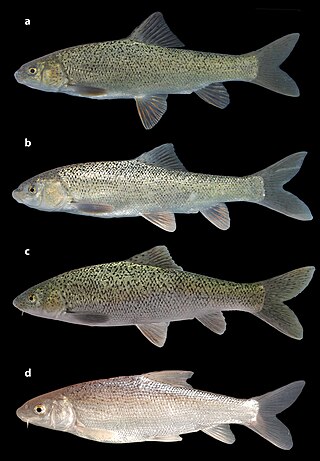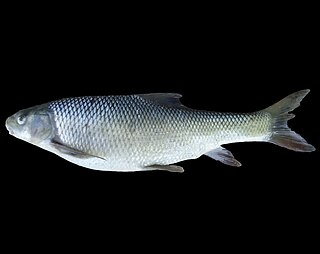
Cyprinidae is a family of freshwater fish commonly called the carp or minnow family, including the carps, the true minnows, and their relatives the barbs and barbels, among others. Cyprinidae is the largest and most diverse fish family, and the largest vertebrate animal family overall, with about 3,000 species; only 1,270 of these remain extant, divided into about 200 valid genera. Cyprinids range from about 12 mm (0.5 in) in size to the 3 m (9.8 ft) giant barb. By genus and species count, the family makes up more than two-thirds of the ostariophysian order Cypriniformes. The family name is derived from the Greek word kyprînos.

Barbus is a genus of ray-finned fish in the family Cyprinidae. The type species of Barbus is the common barbel, first described as Cyprinus barbus and now named Barbus barbus. Barbus is the namesake genus of the subfamily Barbinae, but given their relationships, that taxon is better included in the Cyprininae at least for the largest part.

Puntius is a genus of small freshwater fish in the family Cyprinidae native to South Asia and Mainland Southeast Asia, as well as Taiwan.

Rasbora is a genus of fish in the family Cyprinidae. They are native to freshwater habitats in South and Southeast Asia, as well as southeast China. A single species, R. gerlachi, is only known from an old specimen that reputedly originated from Africa (Cameroon), but this locality is considered doubtful. They are small, up to 17 cm (6.7 in) long, although most species do not surpass 10 cm (4 in) and many have a dark horizontal stripe.
Sinocyclocheilus is a genus of freshwater fish in the family Cyprinidae that is endemic to Guangxi, Guizhou and Yunnan in China. Almost all of its species live in or around caves and most of these have adaptions typical of cavefish such as a lack of scales, lack of pigmentation and reduced eyes. Several species have an unusual hunchbacked appearance and some of the cave-dwellers have a "horn" on the back, the function of which is unclear. In contrast, the Sinocyclocheilus species that live aboveground, as well as a few found underground, show no clear cavefish adaptions. They are relatively small fish reaching up to 23 cm (9.1 in) in length. The individual species have small ranges and populations, leading to the status of most of the evaluated species as threatened. Many species populations in the genus have yet to be evaluated by the IUCN.

Acheilognathus rhombeus is a temperate freshwater fish belonging to the Acheilognathinae sub-family of the family Cyprinidae. It originates in Japan and the Korean Peninsula. It was originally described as Capoeta rhombea by Temminck & Schlegel in 1846. It is the type species for the genus Acheilognathus.

Capoeta, also known as scrapers, is a genus of fish in the family Cyprinidae found in Western Asia. The distribution extends from Turkey to the Levant, to Transcaucasia, Iraq, Turkmenistan, in Armenia, particularly in lake Sevan and northern Afghanistan. This genus is most closely related to Luciobarbus and in itself is divided into three morphologically, biogeographically and genetically distinct groups or clades: the Mesopotamian clade, the Anatolian-Iranian clade and the Aralo-Caspian clade. The Mesopotamian clade was split off to Paracapoeta in 2022.
Capoeta pestai, called the Eğirdir longsnout scraper or the Eğirdir barb, is a critically endangered freshwater fish species in the family Cyprinidae, found only in Turkey. It used to be common across Lake Eğirdir in central Anatolia, but survives only in one of the inflowing rivers. It was forced out of Lake Eğirdir by a combination of overfishing, irrigation, destruction of its habitat, and the induction of predatory alien fish species.

Garra is a genus of fish in the family Cyprinidae. These fish are one example of the "log suckers", sucker-mouthed barbs and other cyprinids commonly kept in aquaria to keep down algae. The doctor fish of Anatolia and the Middle East belongs in this genus. The majority of the more than 160 species of garras are native to Asia, but about one-fifth of the species are from Africa.

Lobocheilos is a genus of fish in the family Cyprinidae native to Asia.

Capoeta damascina, the Levantine scraper or Mesopotamian barb, is a species of cyprinid fish from the Near East region. It is reported from Iraq, Israel, Jordan, Lebanon, Syria, Iran and Turkey.

Paracapoeta erhani, also known as the Ceyhan scraper or Seyhan scraper, is a Turkish species of freshwater cyprinid fish in the genus Paracapoeta.
Capoeta tinca, or the Anatolian khramulya or western fourbarbel scraper, is a species of cyprinid fish endemic to Turkey, inhabiting swiftly flowing rivers.

Hypselobarbus is a genus of fish in the family Cyprinidae endemic to India.

The Cyprininae are one of at least 11 subfamilies of cyprinid fish. It contains three genera in its strictest definition but many more are included depending on which authority is defining it, especially if the Labeobarbinae is not considered to be a valid grouping.

Capoeta razii, is a newly described species of freshwater cyprinid fish occurring mainly in the southern Caspian Sea basin, Iran. This species was mistakenly reported by many authors as Capoeta gracilis in northern Iranian regions. It was first reported to be different from C. gracilis by Levin et al. (2012).
Capoeta ferdowsii is a species of cyprinid in the genus Capoeta, native the Zohreh and Fahlian rivers in Iran. It is named after Persian poet Ferdowsi.
Capoeta pyragyi is a species of cyprinid in the genus Capoeta. It lives in the Tireh and Sezar rivers of Iran, and it is named after Turkmen poet and spiritual leader Magtymguly Pyragy.

Capoeta kaput is a species of algae eating scrapers discovered in 2019. Known locally as the Blue Aras scraper, this rare species prefers large rivers. It has not been evaluated by the IUCN yet but may need protection. The freshwater fish primarily inhabits rivers of the Araxes basin in Asia, and has been found so far in at least Armenia, Iran and Turkey. C. kaput can be distinguished by several physical markers, such as its nine dorsal branched rays, a larger number of vertebrae than most other species in the genus, and it is about 262 mm (10.3 in) in length. The species has been discovered recently enough that it's been the subject of relatively little research.

Paracapoeta is a genus of fish in the family Cyprinidae found in Mesopotamia, Cilicia and the Levant, Western Asia. This genus is closely related to Luciobarbus and was formerly the Mesopotamian clade of Capoeta before being split off in 2022. The generic name alludes to παρά meaning "near" and Capoeta.














